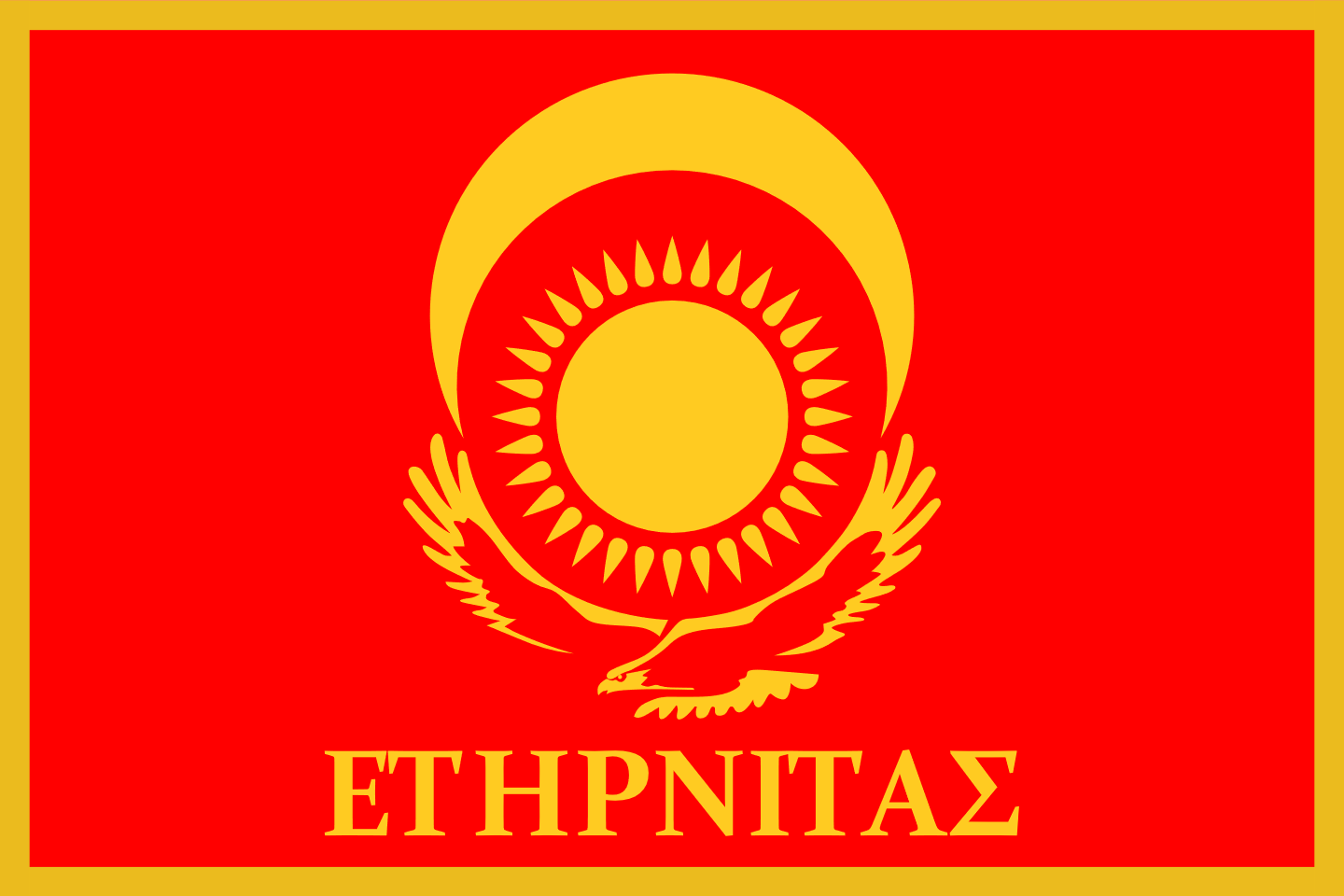Tira Vella
"Fair winds and fair seas ferry us home, for Tira Vella be their home as well."The Tira Vellan Republic (Tira Vellan: Η Ρες Πώλιτη Τίρης Βελλής, /(h)i rez ˈpoliti ˈtiris ve(l)ˈlis/), commonly known as Tira Vella (Τίρα Βέλλα, /ˈtira ˈve(l).la/) is an island country comprising the island of Tira Vella as well as the Gyaros Archipelago, Ala Rena Islands, and several other minor islands. Tira Vella is surrounded by the Great Southern Ocean to the south and east, the Sea of Fog to the west, and the Gyaros Strait to the north, separating it from Sossis. The island of Tira Vella is divided into several distinct geographical and cultural regions.—Pelias Solou
History
The island of Tira Vella has been inhabited for at least thousands of years, with the first known peoples of the region being Karanesians, with Tira Vella likely being the Karanesian homeland. Some time in the first millennium BCA two different groups of Continental peoples arrived in the island: the Arxians and the Tira Vellans. During the Bronze Age, the island appears in Horil records as Korjmurz, and some Horils today still refer to it as Xorinal. In 1576, Derash under king Fyodor II invaded Tira Vella during their interregnum, making a claim to the throne by way of his mother. Following the Dreshan conquest, Tira Vella was ruled in a personal union by the monarchs of Derash for 250 years, until the Eronite War from 1828 to 1841 in which Tira Vella fought to overthrow Dreshan rule. Inspired by tales of the pre-tetrarchy Tira Vellan democracies, and rule by a monarch being seen as generally undesirable after so long under the Dreshans, the leaders of the Tira Vellans set up an aristocratic republic. The first republic was overthrown in 2015 //Geography: Mediterranean climate along the Northeast coast that gives way to desert inland, jungle East of The Grey and South of the Toloén desert, steep mountain ranges along the West that become The Grey to the Western shore, marshlands/swamplands along most of the Southern and Southeastern coast and the Ala Rena Islands.
The Central Jungle (ᾐς ξἢρᾕβ̫ἢ ζἥκᾕγἢς): The jungle resting on a shallow plateau in the centre of Tira Vella. Little is actually known about the region, due to the difficulty of traversal. Motive python vines are capable of strangling animals and people. Home of the steel-clawed dirgos (δᾐργἢς), which is prized for the pure steel of its claws.
Gold Coast (Ο Ζολώνος Ώρισ): The most densely inhabited region of Tira Vella, containing most of the arable land and favourable climate; the cultural centre of the country. Several desirable spices only grow here. It is so named not for any natural resources, but either (depending on who you ask) because of the golden sun that always shines there, or due to the massive wealth the region has accumulated.
The Grey (Ο Άγιος Φαίος): Rough, rocky terrain, craggy mountains with bizarre stone trees, small plains of ash and volcanic sands. The sun is often obscured from seemingly perpetual ash storms. Home to odd, isolated flora and fauna, mostly hearty roots, fungi, lichens, and moss; strange reptiles, large insectoids, and terrestrial crustaceans; home to a few nomadic or semi-nomadic tribes. Host to the only quicksilver mines in the world. In the centre at the site of the crater of whatever catastrophe created the place is the Glass Sea, a region where the land is made of a magical obsidian (so-called blackglass). The Grey is seen as an area of great magical significance.
The Southlands (Αι Χωραί προς Νότον τού Μέσου): The swamplands past the jungle plateau. Poor land fit only to grow saltrice, the staple grain of the region. Home to several useful medicinal herbs and fungi. Most communities are fishing communities, especially those on the Ala Rena Islands (Τα Νισιἀ την Αλα Ρεναικί), which lack the land to grow even saltrice.
Toloïn Desert (Ερημία την Τολοήν): Barren, sandy desert that does little but present obstacle in entering The Grey. The only areas of import are the caravan routes. Notable Cities
Tira Vella Outline
Tira Vellan Republic
Η Ρες Πώλιτης Τίρα Βέλλας"Ετήρνιτας!"
"Forever!"
Government
Federal Directorial RepublicCapital
CaithosHistory
History of Tira VellaLanguages
Majority: Tira Vellan
Minority: Agian, Arpish, TirassianDemonym
Tira VellanCurrency
Tira Vellan Florin
Preceded by
Old Tira Vella
Southlands colonies
Arp tribes
Agians
Kaschehane[debatable]
Alsan (Αλσάν/ᠠᠯᠰᠠᠮ): {Population 600} Not so much a city, but the largest Arpish settlement. There are few permanent buildings, and mostly it consists of tents set up by whomever is currently in the area. Clusters of yurts circle a great stone spire atop a bare, grassy mountain as arps arrive to set up their tents, and others begin to pack theirs away, ready to move on.
Anaís (Αναΐς): {Population 5,500}
Argos Point (Βιζή Αργoσή): {Population 60}
Arthéno (Αρθένο): {Population 12,300} A major city on the Gold Coast; though not a port, it is far from bustling. It is a rare thing, then: a large city that is quiet and tranquil. Perhaps the busiest thing about the city is Kormas University, the oldest university in Tira Vella. It has many parks and gardens, small curiosity shops, and friendly people. One can walk through a park, birds chirping, the sun shining, eating a freshly baked pastry, and forget about the other thousands of people going about their lives around them.
Caithos (Καίθους): {Population 36,000} Large mercantile capital of Tira Vella, located along the Bay of Caithos. It is divided into five districts: the docks, where the working men earn their living loading and unloading exotic goods from ships from around the world, and stories are exchanged in a half-dozen languages in its lively corner clubs; the foreign quarter, where common folk walk down muddy streets from the bakery to their shabby home; the ten streets, a winding series of alleys that serves as a red light district and a place to do business that is more inviting than the foreign quarter, but less expensive than the artisan’s district, which is an expansive upscale downtown; anything one could wish to find can likely be found in one of the shops here; and lastly the merchant’s quarter, where mansions of stone, marble, and rich, dark woods lay next to colourful gardens and well groomed hedges and trees on a walled-off isle.
Corriaba (Κορριάβα): {Population 2,800}
Corrivi (Κόρριβι): {8,500}
Elora (Ελώρα): {Population 230} Oasis town in the Toloén; a pit stop for caravans travelling to The Grey with few permanent inhabitants. Its adobe warehouses will lay dormant for weeks, months, collecting sand and cobwebs only for a caravan to come into town and fill it, only to leave the next morning. Hardly a building in town isn’t owned by a mining company, and hardly a person isn’t employed by one. Those that aren’t are other merchants who sell wares in open markets to caravaneers. People lay along the shore of the oasis under a palm tree while others swim by. Sand builds up along the Southwestern wall as the wind whips across the dunes.
Lycargos (Λύκαργος): {Population 280}
Rela Baramítios (Ρέλα Βαραμίτιος): {Population 1,160} The largest city in the Southlands and one of the only to host stone buildings. Roads may be cobbled, but so much mud and vegetation covers them that one could be forgiven for failing to notice. It is, depending on who you ask, the least miserable place in the Southlands, or the most.
Rumán (Ρουμάν): {Population 560} Host to the world’s largest cinnabar mine, it is also the largest settlement in the Grey. It lies just through a pass in the hills along the coast of the Great Inlet. The stone buildings with thatched roofs wouldn’t look out of place in the grasslands, but their contrast to the dead, rocky landscape and ash-filled winds gives them an almost sinister feel. The town has few accomodations for outsiders, content to serve the miners and caravaneers who transport the ore as few others have reason to travel to the town.
Tavos (Τάβος): {Population 450} A town in the Ala Rena Islands of wooden shacks built from the wood of the surrounding bog trees. Mosses and lichens hang down from branches, dragonflies whizz over cattails as ribbits and chirps fill the air; a fisherman casts his line into the sea from his pier, the sun rising over the sea in front of him.




Comments